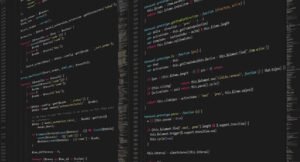Neural Network and Neurons
Neural networks are a computational model inspired by the human brain. They are made up of interconnected units called neurons, which process and transmit information throughout the network.
Key Takeaways:
- Neural networks are computational models inspired by the human brain.
- Neurons are the building blocks of neural networks.
- Neural networks process and transmit information.
In a neural network, each neuron receives input signals from other neurons and performs a computation before passing the result to other neurons. This interconnectedness forms the basis for the network’s ability to learn and make decisions. *Neurons in a neural network can be thought of as artificial counterparts to the biological neurons in the brain, carrying out complex computations to solve problems.*
Neurons in a neural network are organized into layers: an input layer, one or more hidden layers (intermediate layers), and an output layer. The input layer receives and processes data from external sources, while the output layer produces the final result or prediction. The hidden layers, as the name suggests, are not directly accessible and serve to process information between the input and output layers. *The hidden layers play a crucial role in enabling neural networks to learn complex patterns and make accurate predictions.*
| Types of Neurons | |
|---|---|
| Neuron Type | Description |
| Input Neuron | Receives input from external sources and passes it to other neurons in the network. |
| Hidden Neuron | Processes and transmits information between the input and output layers. It performs computations on the received inputs and passes them to other neurons. |
| Output Neuron | Produces the final result or prediction based on the processed information from the hidden layers. |
Neural networks are trained using a process called backpropagation, which adjusts the weights and biases of the neurons to minimize the error between the predicted output and the desired output. This iterative process allows the network to learn from examples and improve its accuracy over time. *Backpropagation is an efficient technique that enables neural networks to continuously update their weights and biases, resulting in improved performance.*
The application of neural networks is vast and spans various fields, including image and speech recognition, natural language processing, and financial forecasting. They have shown great potential in solving complex problems that traditional algorithms struggle with. *Neural networks have revolutionized the field of artificial intelligence and continue to drive innovation and advancement in machine learning.*
Conclusion:
Neural networks, with their interconnected neurons, mimic the computational functioning of the human brain. They have proven to be highly effective in solving complex problems and have greatly contributed to the field of artificial intelligence. As our understanding of neural networks and their applications continues to grow, we can expect even more remarkable advancements in the future.
| Advantages of Neural Networks | |
|---|---|
| Advantage | Description |
| Ability to learn and adapt | Neural networks can learn from examples and adapt their weights and biases to improve accuracy. |
| Handling of complex problems | Neural networks excel at solving complex problems that traditional algorithms struggle with. |
| Wide range of applications | Neural networks are applied in various fields, such as image recognition, natural language processing, and financial forecasting. |

Common Misconceptions
Neural Network
Neural networks are a complex and fascinating field of artificial intelligence, but there are several common misconceptions surrounding their functioning and capabilities.
- Neural networks are not a replica of the human brain: Although inspired by the structure and functioning of the human brain, neural networks are not an exact replica of biological neural networks.
- Neural networks can perform a wide range of tasks: Contrary to popular belief, neural networks are not limited to just image recognition or natural language processing. They can be used for various applications such as time series analysis, recommendation systems, and even game playing.
- Neural networks are not always black boxes: While neural networks are often referred to as black boxes due to their complexity, there are techniques, such as interpretability methods and attention mechanisms, that can provide insights into their decision-making processes.
Neurons
Neurons are the basic units of neural networks, but people often have misconceptions about their structure and behavior.
- Neurons are not isolated units: Neurons in a neural network do not work independently of each other. They are connected through a complex network of weights and biases, allowing them to communicate and collaborate.
- Neurons do not have physical counterparts: In a neural network, neurons do not represent actual biological neurons. They are mathematical abstractions or nodes that process and transmit information using activation functions.
- Neurons are not always binary: While binary activation functions like step functions are commonly used in introductory explanations, neurons in real-life neural networks often use continuous activation functions like sigmoid or ReLU to introduce non-linearities.

The History of Neural Networks
Explore the timeline of key milestones in the field of neural networks, which have shaped the development and understanding of artificial intelligence.
| Year | Event |
|---|---|
| 1943 | McCulloch and Pitts propose the first mathematical model of a neural network. |
| 1956 | Frank Rosenblatt introduces the concept of perceptrons, a type of artificial neuron. |
| 1969 | Marvin Minsky and Seymour Papert publish “Perceptrons,” highlighting the limitations of single-layer neural networks. |
| 1986 | Geoffrey Hinton and colleagues invent the backpropagation algorithm, enabling training of multi-layer neural networks. |
| 2012 | Alex Krizhevsky develops AlexNet, a deep convolutional neural network revolutionizing image recognition. |
Neuronal Structure
Dive into the basic structure of a biological neuron, a fundamental unit of neural networks, comprising essential components for information processing.
| Component | Description |
|---|---|
| Dendrites | Receives electrical signals from other neurons. |
| Soma (Cell Body) | Contains the nucleus and integrates signals received by dendrites. |
| Axon | Transmits electrical signals (action potentials) away from the cell body to other neurons. |
| Axon Terminal | Forms synapses with dendrites of other neurons, aiding in the transmission of signals. |
The Role of Artificial Neurons
Gain an understanding of how artificial neurons, inspired by biological neurons, function within neural networks to process and transmit information.
| Activation Function | Description |
|---|---|
| Sigmoid | Produces an S-shaped output, facilitating non-linear transformations. |
| ReLU (Rectified Linear Unit) | Returns zero for negative inputs and the input value for positive inputs, introducing non-linearity. |
| Tanh | Similar to a sigmoid function but ranges from -1 to 1, allowing negative outputs. |
Common Neural Network Architectures
Discover various architectures employed in neural networks, each designed to solve different types of problems and address specific challenges.
| Architecture | Description |
|---|---|
| Feedforward Neural Network | Information moves in one direction, without loops or cycles, making it suitable for pattern recognition tasks. |
| Convolutional Neural Network | Specialized for processing grid-like data, e.g., images, using convolutional and pooling layers. |
| Recurrent Neural Network | Employs feedback loops to process sequential data, with memory to retain and utilize previous information. |
Training Neural Networks
Learn about the methods utilized to train neural networks through iterative optimization, enabling them to learn from data and improve performance.
| Training Technique | Description |
|---|---|
| Backpropagation | Utilizes gradient descent to update network weights based on the calculated error. |
| Stochastic Gradient Descent (SGD) | Performs weight updates after the presentation of each individual training sample. |
| Adam | An adaptive learning rate optimization algorithm that combines ideas from RMSProp and momentum methods. |
Applications of Neural Networks
Explore real-world applications of neural networks, showcasing their versatility and potential in various domains.
| Application | Example |
|---|---|
| Speech Recognition | Developing voice assistants capable of understanding and responding to natural language. |
| Image Classification | Enabling accurate identification of objects, people, or features within images. |
| Medical Diagnosis | Assisting doctors in diagnosing diseases based on symptoms and medical data. |
Challenges in Neural Network Training
Highlight some challenges faced during the training of neural networks, which impact their effectiveness and performance.
| Challenge | Description |
|---|---|
| Overfitting | When a neural network too closely adheres to training data and fails to generalize well to new data. |
| Vanishing Gradient | Occurs when gradients become extremely small during backpropagation, hindering learning in early layers. |
| Data Scarcity | Insufficient or limited data can impede accurate training and hinder generalization. |
Future Directions in Neural Networks
Explore potential future advancements and applications of neural networks, as the field continues to evolve rapidly.
| Advancement | Description |
|---|---|
| Explainable AI | Efforts to make neural network decisions and processes more transparent and interpretable. |
| Neuromorphic Computing | Developing hardware architectures inspired by the brain’s structure and functionality. |
| Artificial General Intelligence (AGI) | The pursuit of creating neural networks capable of achieving human-level intelligence across various domains. |
Neural networks, inspired by the structure and function of biological neurons, have revolutionized the field of artificial intelligence. From their historical origins to their diverse applications, neural networks have demonstrated remarkable capabilities in speech recognition, image classification, medical diagnosis, and beyond. Although challenges such as overfitting, vanishing gradients, and scarce data persist, ongoing advancements in explainable AI, neuromorphic computing, and the pursuit of artificial general intelligence showcase the exciting future potential of neural networks. As technology continues to advance, neural networks are poised to play a pivotal role in shaping our world and driving further innovations.
Frequently Asked Questions
What is a neural network?
A neural network is a computational model inspired by the functioning of the human brain. It consists of interconnected artificial neurons that are organized into layers to process and analyze complex data.
What are neurons?
Neurons are the basic building blocks of a neural network. They receive inputs, perform computations, and produce outputs based on these computations. Each neuron is connected to multiple other neurons to form a network.
How does a neural network learn?
A neural network learns through a process called training. During training, the network is exposed to a large set of labeled data. The network adjusts the weights and biases of its connections between neurons based on the error it makes while trying to predict the correct output.
What is the activation function in a neural network?
An activation function determines the output of a neuron based on the weighted sum of its inputs. It introduces non-linearities to the network, enabling it to learn complex patterns and make more accurate predictions.
What is backpropagation?
Backpropagation is an algorithm used to train neural networks. It involves computing the gradient of the network’s error with respect to each weight and bias in the network. This gradient is then used to update the network’s parameters in the opposite direction, reducing the overall error.
What is overfitting in neural networks?
Overfitting occurs when a neural network performs exceptionally well on the training data but fails to generalize well on unseen data. It means that the network has memorized the training examples instead of learning the underlying patterns. Regularization techniques, such as dropout or weight decay, can help mitigate overfitting.
What is the difference between deep learning and traditional machine learning?
Deep learning is a subset of machine learning that focuses on training deep neural networks with multiple layers. Traditional machine learning algorithms mainly rely on handcrafted features and explicit instructions, whereas deep learning learns hierarchical representations directly from raw data.
Can neural networks be used for image recognition?
Yes, neural networks excel at image recognition tasks. Convolutional neural networks (CNNs) are especially effective in analyzing visual data, such as images or videos, due to their ability to automatically extract features from the input using convolutional layers.
How are neural networks used in natural language processing?
In natural language processing (NLP), neural networks are used for various tasks like text classification, sentiment analysis, machine translation, and named entity recognition. Recurrent neural networks (RNNs) and transformer models are commonly employed in NLP applications.
What are some limitations of neural networks?
Neural networks can be computationally intensive and require significant amounts of training data to achieve good performance. They are also susceptible to overfitting, may take longer to train compared to other machine learning algorithms, and lack interpretability, making it challenging to understand their internal workings.




